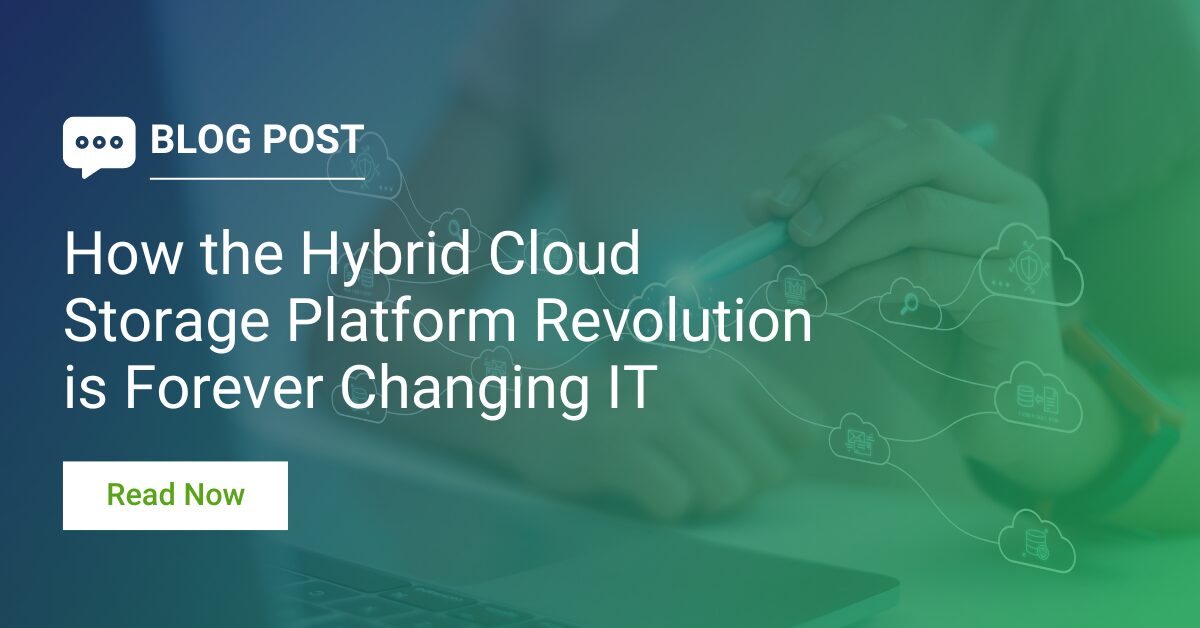How the Hybrid Cloud Storage Platform Revolution is Forever Changing IT
Anne Blanchard shares trends and takeaways from Gartner’s Infrastructure, Operations Cloud Strategies conference around the push for enterprise organizations to move to a hybrid cloud storage platform.
April 3, 2024 | Anne Blanchard

At the end of Gartner’s Infrastructure, Operations & Cloud Strategies (IOCS) conference, I chatted with several IT managers to gauge their reaction to one of the event’s major themes. Unstructured data is growing fast — Gartner expects capacity across on-premise, edge and public cloud to triple by 2026 — and legacy hardware solutions are not up to the challenge. In addition, AI innovation is coming, and I&O leaders need to start experimenting and learning what’s out there now. The overall message was loud and clear: to be ready for both challenges, I&O leaders must transition their organizations to a hybrid cloud storage platform that leverages the cloud’s scalability and depth of resources in order to thrive.
When I spoke with IT managers, this prescribed shift was viewed as a positive development. “I see these changes as an opportunity,” one mid-career manager told me. “This is a chance to start afresh, to improve and innovate.”
His attitude is spot on. This isn’t merely a change in storage technology — it’s going to reorganize departments. Members of I&O teams used to be assigned to specific technology silos. You managed one location and one or several of your colleagues oversaw other silos. Today, the transition away from hardware to cloud platforms is pulling the workforce back to the center. IT professionals are going to be platform-centric and not silo-specific. Gartner expects more than 50% of such professionals are going to work within infrastructure platform teams by 2028.
Four years is not far off. The time to start driving this change and mastering the technology is now. For storage leaders in particular, now is the time to start looking at hybrid cloud storage platforms.
The Advantages of Hybrid Cloud Storage Platforms
So, what is a hybrid cloud storage platform? Gartner defines hybrid cloud storage as a solution that delivers seamless data services to various data centers, edge locations, clouds and platform services. Hybrid cloud storage provides a range of capabilities — including effortless scalability, built-in security, fast edge performance, automation and more — through a single cloud solution that can be deployed anywhere.
The benefits are numerous. Relying on a single, unified cloud-native platform makes it easier for IT managers and directors to roll out services to new locations or regions. The technology operates within the cloud, so it isn’t held back by the capacity or technical constraints of local hardware. There are no limitations on scale. And innovative edge architecture optimizes local application performance while also offering gold-copies of data in the cloud. Companies end up with far more agile infrastructure, too, since they can adapt to both local and centralized needs for data with just one architecture.
There are some fundamental requirements a hybrid cloud storage platform needs to meet — it should be API-focused, software-defined, and both edge and cloud-optimized, for example — but a solution that hits those technical notes will deliver for the business. The Nasuni File Data Platform does exactly that, and we are taking advantage of our technology’s cloud-centric platform design to help our customers innovate. A recent announcement, Nasuni Edge for Amazon S3, is a perfect example. One of our manufacturing customers is reporting a 10X performance increase on data access and ingest speeds, allowing them to vastly increase the amount of quality assurance data they process every day.
Business Impact & AI Readiness
Hybrid cloud storage platforms will play a key role in this transition. Infrastructure teams will be able to deliver more reliable operations, centralize their management of all those once-isolated silos, and limit up-front costs of offering new services through consumption-based pricing models. Yet this isn’t just about platforms. It’s also about skill sets in cloud and AI opportunities that need to be explored. IT managers who move to hybrid cloud infrastructure platforms will be leading their organizations in AI readiness. Why? Because in today’s unstructured data environment, storing, protecting, and moving data from where it’s created to where it’s needed requires the fluidity that only a hybrid cloud storage platform can provide.